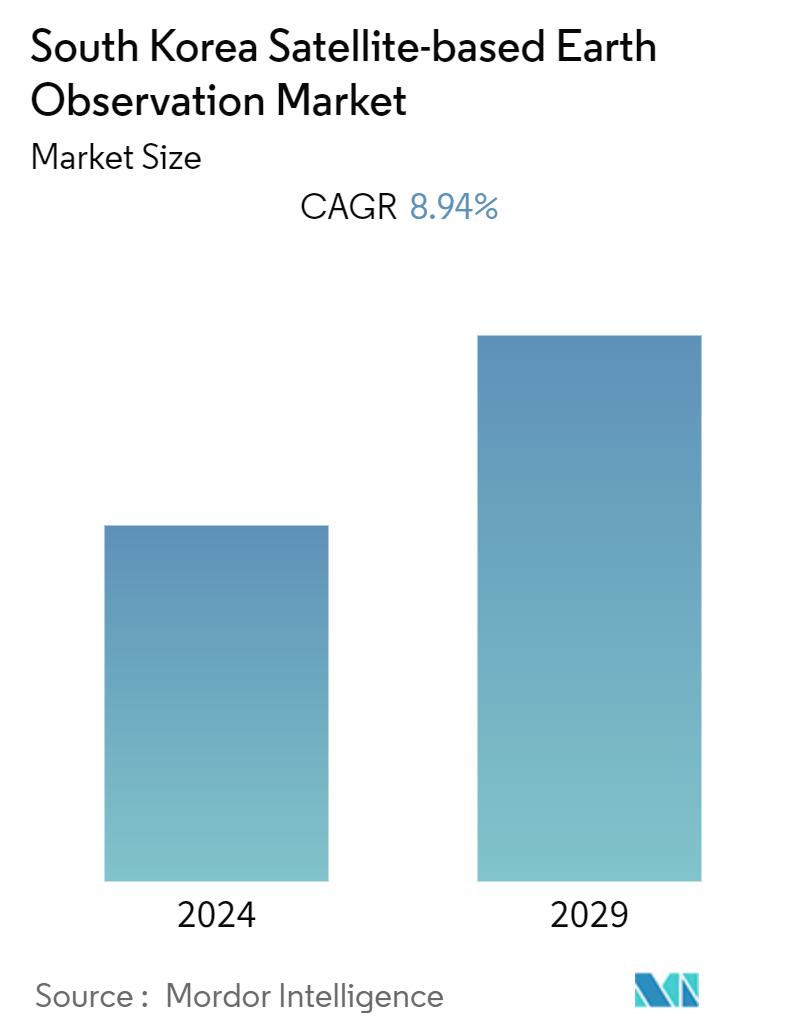Market Size of South Korea Satellite-based Earth Observation Industry

| Study Period | 2019 - 2029 |
| Base Year For Estimation | 2023 |
| Forecast Data Period | 2024 - 2029 |
| Historical Data Period | 2019 - 2022 |
| CAGR (2024 - 2029) | 8.94 % |
| Market Concentration | High |
Major Players
*Disclaimer: Major Players sorted in no particular order |
South Korea Satellite-based Earth Observation Market Analysis
The South Korea Satellite-based Earth Observation Market is expected to register a CAGR of 8.94% during the forecast period.
The growing adoption of earth observation imagery in several applications, such as urban monitoring, disaster management, and agriculture in the region, alongside government aid through space agencies, is analyzed to bolster the market growth rate during the forecast period.
- Satellite-based earth observation is a valuable tool for various applications and domains that can benefit South Korea. It can help meet the increasing demand for satellite-based Earth observation data, particularly in the fields of energy, climate monitoring, disaster management, and reconnaissance and surveillance for military purposes.
- Further, satellite-based earth observation can support the national space development program and the scientific and technological advancement of the country.
- It can enable wider economic benefits and sustainable development in collaboration with international financial institutions (IFIs) and other partners. It can enhance the security and defense capabilities of South Korea against potential threats from North Korea or other adversaries.
South Korea Satellite-based Earth Observation Industry Segmentation
The study tracks the key market parameters, underlying growth influencers, and major vendors operating in the industry, which supports the market estimations and growth rates over the forecast period.
The South Korea satellite-based Earth observation market is segmented by type (earth observation data and value-added services), satellite orbit (low earth orbit, medium earth orbit, and geostationary orbit), and end-use (urban development and cultural heritage, agriculture, climate services, energy and raw materials, infrastructure, and other end-use
The market sizes and forecasts are provided in terms of value (USD) for all the above segments.
| By Type | |
| Earth Observation Data | |
| Value Added Services |
| By Satellite Orbit | |
| Low Earth Orbit | |
| Medium Earth Orbit | |
| Geostationary Orbit |
| By End-Use | |
| Urban Development and Cultural Heritage | |
| Agriculture | |
| Climate Services | |
| Energy and Raw Materials | |
| Infrastructure | |
| Other End-Use |
South Korea Satellite-based Earth Observation Market Size Summary
The South Korea satellite-based earth observation market is experiencing significant growth, driven by the increasing adoption of earth observation imagery across various applications such as urban monitoring, disaster management, and agriculture. Government support through space agencies and substantial investments in space programs are key factors propelling the market forward. The South Korean government has allocated considerable funds for the development of remote sensing satellites, which are expected to enhance resource management and environmental monitoring capabilities. These initiatives are part of a broader national space development program aimed at advancing scientific and technological progress, as well as supporting economic benefits and sustainable development in collaboration with international financial institutions.
The market is further bolstered by the country's urban development projects and smart city initiatives, which leverage satellite-based earth observation for urban planning and monitoring. Seoul's urban design plan and the establishment of national pilot smart cities like Sejong and Busan exemplify the integration of advanced technologies to improve urban living conditions. Additionally, partnerships with global technology companies, such as the collaboration between Dabeeo and Maxar Technology, are expanding the market's reach by enhancing geospatial information services. These developments, alongside the launch of commercial-grade satellites and innovative earth observation services, underscore the dynamic growth and strategic importance of the satellite-based earth observation market in South Korea.
South Korea Satellite-based Earth Observation Market Size - Table of Contents
-
1. MARKET INSIGHTS
-
1.1 Market Overview
-
1.2 Industry Attractiveness - Porter's Five Forces Analysis
-
1.2.1 Bargaining Power of Buyers
-
1.2.2 Bargaining Power of Suppliers
-
1.2.3 Threat of New Entrants
-
1.2.4 Threat of Substitutes
-
1.2.5 Intensity of Competitive Rivalry
-
-
1.3 Assessment of Macro-Economic factors in the Market
-
-
2. MARKET SEGMENTATION
-
2.1 By Type
-
2.1.1 Earth Observation Data
-
2.1.2 Value Added Services
-
-
2.2 By Satellite Orbit
-
2.2.1 Low Earth Orbit
-
2.2.2 Medium Earth Orbit
-
2.2.3 Geostationary Orbit
-
-
2.3 By End-Use
-
2.3.1 Urban Development and Cultural Heritage
-
2.3.2 Agriculture
-
2.3.3 Climate Services
-
2.3.4 Energy and Raw Materials
-
2.3.5 Infrastructure
-
2.3.6 Other End-Use
-
-
South Korea Satellite-based Earth Observation Market Size FAQs
What is the current South Korea Satellite-based Earth Observation Market size?
The South Korea Satellite-based Earth Observation Market is projected to register a CAGR of 8.94% during the forecast period (2024-2029)
Who are the key players in South Korea Satellite-based Earth Observation Market?
Satrec Initiative Co., Ltd., Dabeeo Inc., Geofocus Co., Ltd., Airbus and Korea aerospace industries ltd are the major companies operating in the South Korea Satellite-based Earth Observation Market.

